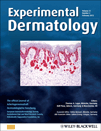Fatty acids and vitamins generate singlet oxygen under UVB irradiation
Abstract
Abstract: UVB radiation is already known as initiator and promoter of carcinogenesis in skin. UVB is well absorbed in proteins and DNA leading to products such as cyclobutane pyrimidine dimers. In contrast, UVA radiation generates reactive oxygen species such as singlet oxygen, which can initiate a variety of cellular damages and cellular signalling. It was the goal to investigate whether and to which extent UVB radiation is additionally able to cause oxidative damages via singlet oxygen. Potential endogenous photosensitizers such as vitamin B molecules or unsaturated fatty acids were irradiated in solution using monochromatic UVB radiation at 308 nm. Singlet oxygen was directly detected and quantified by its luminescence at 1270 nm. All investigated endogenous photosensitizers showed clear singlet oxygen signals with a quantum yield ranging from 5 to 40%. UVB radiation altered the photosensitizer molecules during irradiation yielding a change of absorption in the entire ultraviolet spectrum (280–400 nm). UVB irradiation of endogenous photosensitizers produced singlet oxygen that in turn changes the absorption of those molecules. Being an important prerequisite, the changed absorption may either reduce or increase singlet oxygen production. An increase in singlet oxygen generation may initiate a vicious cycle that has the potential to amplify UVB- or UVA-mediated effects in skin cells.




